Sweden’s house price boom is officially over
Swedish house prices are expected to continue falling this year. The background: stricter mortgage requirements; deteriorating investor confidence, coupled with slowing economic growth.

Sweden’s nationwide house price index fell by 1.53% (-3.55% inflation-adjusted) during 2018, in contrast to y-o-y rises of 7.57% in 2017, 6.29% in 2016, 12.5% in 2015 and 8.57% in 2014, according to Statistics Sweden. During the latest quarter house prices were unchanged (fell slightly by 0.19% inflation-adjusted) in Q4 2018.
By region:
- Greater Stockholm house price index fell by 7.1% y-o-y in 2018 (-9% inflation-adjusted), compared with last year’s rise of 4.5%. Quarter-on-quarter, house prices dropped 0.7% during the latest quarter.
- Greater Göteborg house prices dropped 2.1% (-4.1% inflation-adjusted), in contrast to a y-o-y surge of 9.9% a year earlier. House prices rose by 1.2% during the latest quarter.
- Greater Malmo house prices increased a meager 0.6% (fell by 1.4% inflation-adjusted), a sharp slowdown from a y-o-y growth of 10.5% in the prior year. Quarter-on-quarter, house prices dropped 0.2% in Q4 2018.
Demand and supply are now falling. The total number of homes sold in one- to two-dwelling buildings fell by 4.9% y-o-y to 52,299 units in 2018, according to Statistics Sweden.
In 2018, dwelling starts in newly constructed one- to two-dwelling buildings fell by 19.8% y-o-y to about 10,424 units. Likewise, dwelling completions also dropped 5.1% to 11,813 units over the same period.
Recently, the National Institute of Economic Research revised downwards its 2019 growth projections for Sweden to just 1.3%, from an earlier forecast of 1.9%, amidst a decline in housing investment. The Swedish economy grew by about 2.3% last year, after annual growth rates of 2.1% in 2017, 2.7% in 2016, 4.5% in 2015 and 2.6% in 2014, according to Statistics Sweden.
A housing market correction is inevitable
While Stockholm moved out of bubble risk territory last year, based on the 2018 UBS Global HoHYPERLINK "https://www.ubs.com/global/en/wealth-management/chief-investment-office/our-research/life-goals/2018/global-real-estate-bubble-index-2018.html"using Bubble Index, house prices remain overvalued.
"For a long time, Swedish housing prices have risen sharply and are high in a historical perspective," says the Riksbank. "Over the last ten years alone, house prices have doubled and tenant-owned apartment prices have tripled," it added.
"This means that the probability of a fall in prices is elevated.
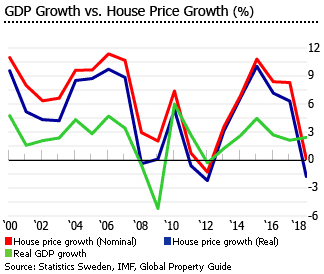
"Together with increasing indebtedness in the household sector, this has made households, financial institutions and the financial system as a whole more vulnerable. In the event of a serious economic shock, the consequences for the Swedish economy could be great."
Before house prices began to fall last year, the European Commission has already noted that Sweden is experiencing structural imbalances.
"Persistent house price growth from already overvalued levels coupled with a continued rise in household debt poses risks of a disorderly correction," noted the Commission. "The already high household indebtedness keeps growing, while housing prices, which appear to be overvalued, continue to rise at an elevated pace."
The average debt-to-income ratio for households with new mortgages currently stand at 411%, up from 402% in 2016, according to the Swedish Financial Services Authority (Finansinspektionen). In fact in Stockholm, the debt ratio for households with new home loans is 534% - equivalent to more than five times their annual income after tax.
Based on a study conducted by Goldman Sachs, comparing house prices in G-10 nations (those with the 10 most-traded currencies) based on three metrics: price-to-rent ratio, price-to-income ratio, and inflation-adjusted house prices, Sweden has a probability of a housing bust of above 35%, higher than Canada (30%), Norway, Australia and Switzerland (20% to 25%).
The government’s market cooling measures
The government introduced a number of measures in recent years.
From June 1, 2016, mortgage loans over 50% of the value of the property have had to be amortized (i.e, paid back) at 1% every year, by Riksbank fiat, while loans worth 70%+ of the property’s value must be amortized at 2% annually. Mortgage loans with LTV ratio between 50% and 70% must be amortized at a minimum of 1% annually.
Then in March 2018 Riksbank required that new housing loan borrowers, whose housing debts exceed 4.5 times their gross income, must amortize at least 1% additional to the fundamental amortization requirements.
For several years, interest-only loans have been curbed by the banks. In addition, the Swedish Financial Services Authority has also introduced a risk weight floor for mortgages in order to tie up more capital in relation to banks’ mortgage lending. Currently, the risk weight floor for mortgages is 25%.
History of the Swedish house-price boom
Sweden’s present house price boom started in mid-1990s. The boom was set off by low interest rates, rapid economic growth and lack of new supply. Mortgage interest rates fell from 10%+ in 1996, to less than 5% between 2004 and 2008.
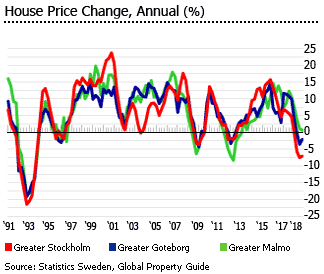
From 1996 to 2007, the Greater Stockholm house price index soared 217% (119% inflation-adjusted), while Greater Malmo rose 236% (185% inflation-adjusted), and Greater Gothenburg rose 202% (156% inflation-adjusted).
There was a pause in 2008 and 2012. But house prices soared again by 45.1% from 2012 to 2017 (40.7% inflation-adjusted).
Local house price variations
During the recent price-decline, Greater Stockholm saw the biggest annual decline in house prices of 6.5% in 2018, to an average of SEK 5,407,000 (€512,637), according to Statistics Sweden.
Greater Göteborg’s average house price fell by a modest 2.7% y-o-y to SEK 4,486,000 (€425,317) in 2018 while Greater Malmö’s house prices increased slightly by 1.2% to SEK 3,839,000 (€363,975).
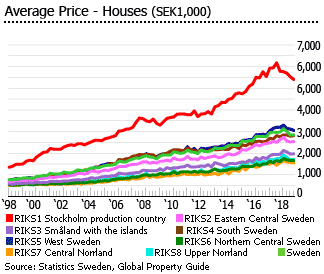
Of the eight Riksområden (National Areas), RIKS1 Stockholm production county registered the biggest y-o-y decline of 6.5% (-8.4% inflation-adjusted) during 2018, followed by RIKS5 West Sweden (-4.5%), RIKS2 Eastern Central Sweden (-3.4%), RIKS8 Upper Norrland (-2.1%) and RIKS7 Central Norrland (-0.9%).
House Prices in Sweden’s 8 Riksområden (National Areas) |
||||
| Average house prices | y-o-y change (%) | |||
| National Areas | SEK | EUR | Nominal | Real |
| RIKS1 Stockholm production county | 5,407,000 | 512,637 | -6.5 | -8.4 |
| RIKS2 Eastern Central Sweden | 2,536,000 | 240,438 | -3.4 | -5.4 |
| RIKS3 Småland with the islands | 1,971,000 | 186,870 | 1.2 | -0.9 |
| RIKS4 South Sweden | 2,812,000 | 266,605 | 2.2 | 0.1 |
| RIKS5 West Sweden | 3,052,000 | 289,360 | -4.5 | -6.5 |
| RIKS6 Northern Central Sweden | 1,659,000 | 157,290 | 3.0 | 0.9 |
| RIKS7 Central Norrland | 1,550,000 | 146,955 | -0.9 | -2.9 |
| RIKS8 Upper Norrland | 1,721,000 | 163,168 | -2.1 | -4.1 |
| Sources: Statistics Sweden, Global Property Guide | ||||
RIKS1 Stockholm production county has the most expensive housing in Sweden with an average dwelling price of SEK 5,407,000 (€512,637) in 2018.
Nationwide house prices stood at an average of SEK 2,848,000 (€270,018) in 2018, down 4.4% from a year earlier.
Home sales falling
Demand is now falling. The total number of homes sold in one- to two-dwelling buildings fell by 4.9% y-o-y to 52,299 units in 2018, according to Statistics Sweden. It was actually the lowest sales in five years.
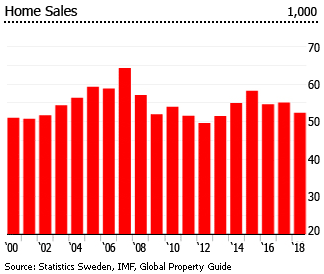
In 2018:
- In Greater Stockholm, home sales dropped 7.3% y-o-y to 7,858 units
- In Greater Göteborg, home sales fell by 4% y-o-y to 4,282 units
- In Greater Malmo, home sales fell by 3% y-o-y to 3,351 units
RIKS5 West Sweden, RIKS2 Eastern Central Sweden, and RIKS4 South Sweden accounted for more than half of all sales in 2018.
Residential construction activity weakens
Dwelling starts in newly constructed one- to two-dwelling buildings in Sweden fell by 19.8% y-o-y in 2018 to about 10,424 units in 2018, according to Statistics Sweden. Likewise, dwelling completions also dropped 5.1% to 11,813 units over the same period.
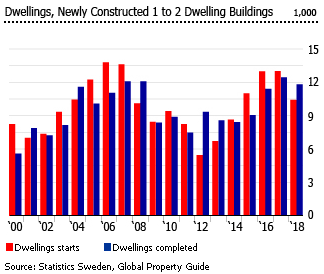
Almost all regions experienced weaker construction activity in 2018:
- In Greater Stockholm, dwelling starts in newly constructed one- to two-dwelling buildings dropped 38.7% y-o-y to 1,560 units in 2018 and completions fell by 16.3% to 2,270 units.
- In Greater Göteborg, dwelling starts fell by almost 17% y-o-y to 1,226 units while completions dropped 15% to 1,166 units
- In Greater Malmo, dwelling starts fell by 7.3% y-o-y to 859 units while completions increased 4.7% to 847 units
- In Sweden excluding metropolitan areas, dwelling starts plummeted by 15.7% y-o-y to 6,779 units in 2018 and completions fell slightly by 0.3% to 7,530 units over the same period

Total housing stock reached 4,859,252 units in 2017, up 1.3% from a year earlier. Of which, 42.6% were dwellings in one- to two-dwelling buildings; 50.7% were in multi-dwelling buildings; and 5.1% were special housing.
Rents rising modestly
Rents for dwellings in Sweden rose by a modest 2.1% in 2018 from a year earlier, to an average of SEK 6113 (€578) per month, according to Statistics Sweden.
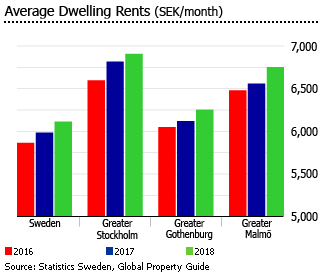
In 2018:
- In Greater Stockholm, the average monthly rent for newly constructed dwellings increased 1.3% y-o-y to SEK6,907 (€653)
- In Greater Göteborg, the average monthly rent for newly constructed dwellings increased 2.2% y-o-y to SEK6,255 (€591)
- In Greater Malmo, the average monthly rent for newly constructed dwellings rose by 3% y-o-y to SEK6,751 (€638)
Swedish law requires that rent-setting be negotiated between tenant organizations and MHCs or private landlord organizations. Private rents are compared to social housing rents, which leads to rent conformity across tenures.
Every year, rent rises are negotiated between the tenants’ association, representing about 350,000 tenants, and the Stockholm property agency, representing 5,000 private rental companies. Over the past decade, rents have risen by about 19% - not far ahead of inflation, which was about 14%.
Interest rates are at historic lows
In February 2019, the Riksbank left its policy rate unchanged at -0.25%, following a surprise 25 basis points rate hike in December 2018 (the first time in seven years). It is one of the lowest benchmark interest rates in the world.

As a result, mortgage interest rates remained very low. In December 2018:
- The average interest rate for housing loans with a maturity of up to 1 year stood at 1.55%, slightly down from 1.6% a year earlier.
- For loans with maturity of over 1 year and up to 5 years, the average interest rate fell to 1.7%, down from 1.81% a year ago.
- For loans with maturity of over 5 years, the average interest rate fell to 2.84%, down from 3.18% a year ago.
Mortgage market continues to surge
Record low borrowing costs have caused a surge in housing loans, which grew from just 52.7% of GDP in 2004 to 74.4% of GDP in 2010, and finally to about 87% of GDP in 2018.
"Several factors explain the increasing residential lending. One important factor is the lack of housing," said Christian Nilsson of Swedish Bankers’ Association. "The Swedish population is growing in record numbers due to high immigration and relatively high birth rates."
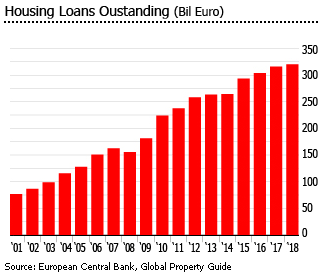
"Another factor is the dysfunctional rental markets in the growth regions due to a general rent control, which results in many years of queuing to get a rental apartment on the first-hand market," added Nilsson.
In December 2018, housing loans outstanding rose by 1.3% y-o-y to €320.1 billion, according to the European Central Bank. In the past 15 years housing lending to households has soared by almost 230%.
Economic slowdown
Recently, the National Institute of Economic Research revised downwards its 2019 growth projections for Sweden to just 1.3%, from an earlier forecast of 1.9%, amidst a decline in housing investment. The housing market and construction sector are key drivers of economic growth in Sweden.
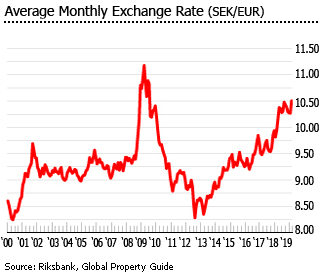
The Swedish economy grew by about 2.3% last year, after annual growth rates of 2.1% in 2017, 2.7% in 2016, 4.5% in 2015 and 2.6% in 2014.
“We’ve seen a halving of new construction projects this year compared with 2017 and 2018. This affects the Swedish economy,” said Anders Lago of the Swedish housing association HSB. “Perhaps there will be a decline in GDP by half a percentage point. And that slows down growth in Sweden”
Because of persistently low inflation, the Swedish crown continues to plummet against the euro, losing almost 10% of its value in the past two years, with the monthly average exchange rate reaching SEK 10.502 = EUR 1 in February 2019 – the lowest level in almost a decade. Likewise, the Swedish crown also lost about 13% of its value against the US dollar in the past year, from a monthly average exchange rate of SEK 8.0552 = USD 1 in February 2018 to SEK 9.2523 = USD 1 in February 2019.
Inflation was 1.9% in January 2019, slightly down from 2% in December 2018 but up from 1.6% in the same period last year, according to Statistics Sweden.
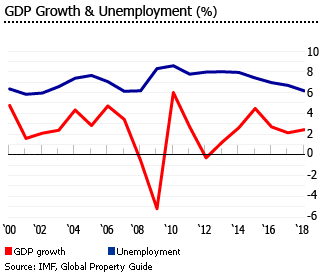
The Swedish central government recorded a budget surplus of SEK 80 billion (€7.58 billion) in 2018, equivalent to about 1.7% of GDP, up from surpluses of 1.3% in 2017, 1.2% in 2016, 0.2% in 2015 and a deficit of 1.6% in 2014. As percent of GDP, debt decreased to just 26% - the lowest level in 40 years.
However government finances are expected to weaken in coming years amidst the economic slowdown.
“The new forecast shows that the budget balance will turn from a surplus of SEK40 billion (€3.8 billion) in 2019 to a deficit of SEK 30 billion (€2.84 billion) in 2020,” according to the Swedish National Debt Office .
Unemployment stood at 6.5% in January 2019, down from 7% a year earlier, according to Statistics Sweden.
Sources:
- Housing, construction and building (Statistics Sweden): https://www.scb.se/en/finding-statistics/statistics-by-subject-area/housing-construction-and-building/
- Sweden interest rate (Trading Economics): https://tradingeconomics.com/sweden/interest-rate
- Sweden’s Economy Expands Twice as Fast as Estimated to End 2018 (Bloomberg): https://www.bloomberg.com/news/articles/2019-02-28/sweden-s-economy-revives-in-fourth-quarter-amid-slowdown-fears
- Sweden’s GDP increased 1.2 percent in fourth quarter of 2018 (Statistics Sweden): https://www.scb.se/en/finding-statistics/statistics-by-subject-area/national-accounts/national-accounts/national-accounts-quarterly-and-annual-estimates/pong/statistical-news/national-accounts-fourth-quarter-2018/
- Labor Force Surveys (Statistics Sweden): https://www.scb.se/AM0401-en
- Swedish budget surplus to fall to 40 bln SEK in 2019 – Debt Office (Nasdaq): https://www.nasdaq.com/article/swedish-budget-surplus-to-fall-to-40-bln-sek-in-2019--debt-office-20190220-00113
- Large surplus for Swedish central government in 2018 (Globenewswire): https://globenewswire.com/news-release/2019/01/09/1682575/0/en/Large-surplus-for-Swedish-central-government-in-2018.html
- Swedish crown hits lowest level since 2016 (Hellenic Shipping News): https://www.hellenicshippingnews.com/swedish-crown-hits-lowest-level-since-2016/
- Swedish central government debt at lowest level in 40 years (Swedish National Debt Office): https://www.riksgalden.se/en/For-investors/Newsroom/News-and-press-releases/News/2019/swedish-central-government-debt-at-lowest-level-in-40-years/
- Sweden government budget (Trading Economics): https://tradingeconomics.com/sweden/government-budget
- Sweden’s housing crisis hits construction industry (Xinhuanet): http://www.xinhuanet.com/english/2019-02/22/c_137843252.htm
- UBS Global Real Estate Bubble Index (UBS): https://www.ubs.com/global/en/wealth-management/chief-investment-office/our-research/life-goals/2018/global-real-estate-bubble-index-2018.html
- EU Commission says Sweden risks disorderly housing market correction (Reuters): https://in.reuters.com/article/eu-budget-sweden-idINL8N1IO1SY
- The Swedish Mortgage Market (Swedish Financial Services Authority): https://www.fi.se/contentassets/e50ed7ac94454af191625a898190073b/bolan_2018_eng_ktt.pdf
- World Economic Outlook Databases (International Monetary Fund): https://www.imf.org/en/Publications/SPROLLS/world-economic-outlook-databases#sort=%40imfdate%20descending
- Minor rent change in dwelling stock (Statistics Sweden): https://www.scb.se/en/finding-statistics/statistics-by-subject-area/housing-construction-and-building/housing-and-rent-data/rents-for-dwellings/pong/statistical-news/rents-for-dwellings-2018/